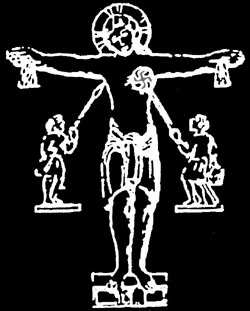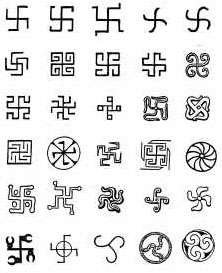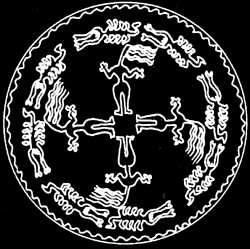THE SWASTIKA
FROM ORIGINS THROUGH PRESENT
DAYS
Fernando Coimbra
coimbra.rockart
(at) yahoo.com
@rtefact
Preliminary Note:
The
perverse use by the Nazi regime of
the swastika symbol under its
"clockwise
gamma-like" version
as a racist
"arian" emblem
has occulted for nearly three
generations of researchers
the scientific studies of this
very old symbol.
Thanks to Fernando Coimbra, we now have a fair
overview
of this symbol, clockwise
as well as counterclockwise,
which obviously belongs to the heritage of the humankind.
In the 19th Century, several authors
attributed
different meanings to the swastika symbol:
image of the supreme god, solar symbol,
depiction of the lightning, symbol of fire,
depiction of the water,
union of the male and female sex, among others.
Whatever has been the various meanings of
the
swastika,
this symbol has been widely used
over millennia,
being associated to the
symbolic-religious world of several peoples including the Christian
world.
For example, on the following Christian funerary inscription

the swastika appears first,
larger than the Chi ro – the emblem of
Christ –
apparently playing, here, the prime role.
In another case it even appears as the symbol of Jesus’ heart
itself .

The meaning of the swastika
has changed in time and space, as
its associations with elements and different objects where it was
depicted.

It is therefore a severe mistake to attribute - as
did several researchers in the
19th Century -
a unique and same meaning to the different kinds of
swastikas, found in the
different parts of the world.
The origin of the swastika is lost in the
night of
ages.
White racist ideologues present it as an Arian symbol,
but such a theory
doesnot hold against archaeological findings.
In Eastern Europa were found potteries
with swastikas belonging to the 6th and 5th millennia BC
and in Mesopotamia this symbol
appeared on pottery from the 5th and 4th millennia BC, therefore pre-Arian
artefacts.
The oldest swastika I know of is depicted on a ceramic vessel from
Bylany, Bohemia and
belongs
to the 6th millennium BC.

The swastika symbol took
several shapes over time.
The following picture is certainly one of the most curious example:

the symbol is formed by the
waving hair and the bodies of four women.
The swastika symbol had an extraordinary
survival,
in space and in time,
having being used by so many cultures and reaching the present days.
Some might even argue that it remained deeply inside in what C. G. Jung
called the
"collective unconscious",
that is, the supposed part of the mind that records
and conserves the psychological heritage of all mankind.
With this article, that may be considered as
a
small virtual exhibition,
I intend to spread examples of swastikas that demonstrate the
wide diversity of meanings attributed to this symbol.
Surely each image deserves a
detailed commentary,
but that would made its reading on-line tedious.
According
to the proverb that says "it’s
better an image than a thousand words"
follows hereafter a "Swastika
Pictorial Atlas",
i.e.: a collection of
56 figures to which I added a short
caption.
Click here
for
access to the "Swastika Pictorial Atlas"
back
to the index of archaeometry.org




